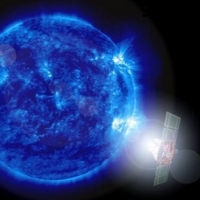SOHO Mission Extension
24 May 2006
At the Science Programme Committee (SPC) meeting on 15-16 May, an extension of the SOHO mission was approved, pushing back the mission end date from April 2007 to December 2009. The new funding ensures that SOHO plays a leading part in the fleet of solar spacecraft scheduled for launch over the next few years.Since its launch on 2 December 1995, The Solar and Heliospheric Observatory (SOHO) has provided an unprecedented view of the Sun - and not just the side facing the Earth. Two teams have now developed techniques for using SOHO to study the conditions on the far side of the Sun.
 |
|
Artist's impression of SOHO, with EIT image of the Sun at 171 Å |
More than 2300 scientists have used data from the solar observatory to forward their research, publishing over 2400 scientific papers in peer-reviewed journals. During the last two years, at least one SOHO paper has been accepted for publication every working day.
During the next two years, five new solar spacecraft will join SOHO in orbit. ESA is involved in two of these spacecraft. The Japan Aerospace Exploration Agency (ISAS/JAXA) has built Solar B, which is scheduled for launch later this year. ESA will supply the use of a ground station at Svalbard, Norway in exchange for access to the data.
Next year, ESA will launch Proba-2, a technology demonstration satellite that carries solar dedicated instruments. In particular, it will carry a complementary instrument to SOHO's EIT camera. Whilst EIT concentrates on the origin and early development of solar eruptions, Proba-2's camera will be able to track them into space.
NASA plans to launch the STEREO pair of spacecraft later this year, and the Solar Dynamics Orbiter in 2008. Far from making SOHO obsolete, these new solar satellites embrace it as a crucial member of the team. SOHO will provide a critical third point of view to assist the analysis of STEREO's observations. Also, SOHO's coronagraph will remain unique. The instrument is capable of blotting out the glare from the solar disk so that the tenuous outer atmosphere of the Sun becomes visible for study.
This fleet of spacecraft will advance the International Living With a Star programme (ILWS), an international collaboration of scientists dedicated to a long-term study of the Sun and its effects on Earth and the other solar system planets.
ILWS will possibly culminate in the launch of the advanced ESA satellite, Solar Orbiter, around 2015. It is designed to orbit close to the Sun, to gain a close-up look at the powerful processes at the heart of our Solar System.
